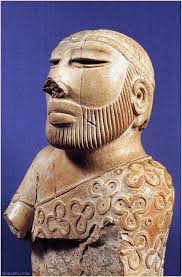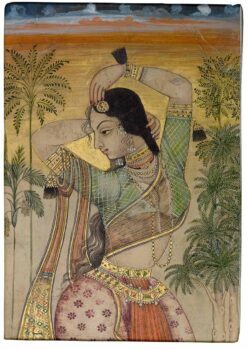 I was talking to a person of South Indian Brahmin origin today about their genetics. Over the course of the conversation, he showed me Y and mtDNA haplogroup types amongst his jati. The vast majority of the Y haplogroups were not R1a.
I was talking to a person of South Indian Brahmin origin today about their genetics. Over the course of the conversation, he showed me Y and mtDNA haplogroup types amongst his jati. The vast majority of the Y haplogroups were not R1a.
Brahmin groups in India seem to be about 15% to 30% steppe in their overall genome. But their Y chromosomes are usually 50% or so R1a1a-Z93. The lineage associated with Indo-Iranian pastoralists.
So what’s going on with the other haplogroups? For example, J2, L, C, G, and H?
From what I can see J2 and L are the next most frequent haplogroups after R1a1a-Z93. This tells us something. These are haplogroups found in ancient “Indus Periphery” samples. And, these two haplogroups are found at high concentrations in the northwest of the subcontinent.
It doesn’t take a {{{Brahmin}}} to connect the dots here. Some of the gotra as early as the Vedic period were almost certainly derived from high-status individuals in the post-IVC society. Warriors and priests in the fallen civilization of the IVC, which had likely degraded itself to a level of barbarism by the time the Indo-Aryans became ascendant.
I like to make jokes about “sons of Indra.” But let’s give the dasyu credit where it’s due: those Indians carrying J2 and L almost certainly descend from the men who build the great cities of yore. Their dominion was lost when their civilization fell, but they integrated themselves into the new order.

Do u have any idea what % fraction of Indian men have Haplogroups not which aren’t R1A ( or other steppe ) and IVC( J2+I).
In other words what % of Indian Men could possibly have Non Steppe / Non IVC great forefathers ? ( Not implying that all others would be non steppe Non IVC ) but thta would be higher possible limit
Is R-L295 (R2a1) also IVC or is it steppe (or AASI)? I thought it was IVC, based on what 23andme tells me, but I don’t see it in your list above.
Were the IVC priest-kings the Saptarishi in the Vedic Corpus? This is a conclusion that’s only prevented from being assessed by the irrational insistence on separating the IVC from the Vedic corpus.
What does the lore say? Agastya, one of the Saptarishi, travels from the north to the South. He guides several clans on a journey of migration from Dwarka to Kongunadu. He also compiles the first rules of Tamil grammar.
Iravatham Mahadevan lay great emphasis on this attestation. He said many of the similar features in Tamil and Sanskrit grammar rules can only be explained by a common origin or master.
This conjecture is faithful to the Indian historical tradition preserved over the generations. But this also says something about the IVC, isn’t it?
Mythology is not a historical tradition, unless you believe mountains bow and cease to grow on human command.
The story of Agastya is much later, and post-Sangam, putting it a solid 1500 years after the period. There are plenty of these classical and post-classic stories that tend to serve as backfill on previous events, but they aren’t Vedic at all.
The ancient historical tradition is like this only – it uses metaphors to convey meaning. You have no clue about mainstream Indian scholarship (like Iravatham Mahadevan) who have crafted many papers focusing on oral histories.
Only unfiltered idiots chase literal significance. You will probably classify Livy, Frontinus and Sosylus as “mythology” – because they describe Hannibal as having met with Zeus.
Maybe there is a correlation between the different zones of IVC and J and L frequency. More specifically the western IVC had more J and eastern IVC had more L. Just a hypothesis.
In the ethnic/tribal patchwork that may have been the southern IVC, the proto-dravidians may have been on the margins for all we know, and opportunistically expanded during the decline. The gap between the close of IVC and rise of urbanization in the deccan seems to be >1000 years. Reversion to barbarity notwithstanding, the ash-mound cultures of the tungabhadra basin seem far too primitive to be direct cultural descendants or urbane mohenjo-daro/lothal type people. I’m imagining the dravidians as some cluster of trans-balochistan agro-pastoral tribes that perhaps brought sahelian crops and sheep to the dry inland deccan and fused with the AASI megalithic people to form proto-south dravidians. Perhaps AASI was highly diverse and long adapted to specific south asian ecologies and as such, a branch of these proto-south dravidians penetrated and assimilated the maritime adapted AASI of the southern peninsular extremity and became proto-Tamils. Finally, highly influential central-eastern gangetic trader-missionaries settled and brought written culture and other prerequisites for the sangam era culture to emerge.
India’s prehistory is quite heterogeneous. Some places were in the mesolithic phase until nearly 4000 years ago and Kashmir was still in the neolithic when the IVC was in the mature period. There are several late copper age sites in an otherwise bronze age period as well.
It is possible that a southern neolithic fringe in north India is responsible for Dravidian migrations further south since the neolithic of south India is roughly contemporaneous to the converging date for existing Dravidian languages.
Girmit and DaThang both have good points. If we look at the area of strongest linguistic diversity, it looks like Proto-South Dravidian diversity focuses on the highland regions of Southern India, stretching from Coorg, into the BR hills, Nilgiris and terminating in the Annamalai hills. You see the borders of South Dravidian languages meeting here, and the Nilgiris alone a a huge centre of diversity.
I would love to get more Nilgiri genetic samples (they actually have a grave and burial culture), but I think that Proto-South Dravidian might have emerged from a highland culture, with IVC-like people staying in the hills, with AASI in the plains. The IVC descendants slowly absorbed AASI groups, as they pushed towards the plains.
Fundamentally, we need better resolutions on Indian specific haplogroups to see when they divided and bifurcated into elite vs non-elite lineages. The most we have now is that H is 40,000 years old, but we don’t really have much study on the branches and divisions that coalesced in the past 4000 years.
https://www.yfull.com/tree/H/
H has an interesting split.
IVC-like people staying in the hills, with AASI in the plains
This would be very strange. Usually earlier settlers tend to occupy the heights, which offer inherent advantage against conquest by outsiders. Climatically, there’s nothing inhibiting plains settlers in peninsular India from populating the hills, which also offer more to hunter-gatherers than farmers (and I assume the AASI were the former and the IVC settlers the latter)
Normally, yes, but the climatic differences in South India are significant. The Nilgiris have a climate that is almost English (frosts and rare snow in winter). That said, the Nilgiris have been split between agriculturalists/pastoralists (Badagas, Todas, Kotas) and hunter-gatherers (Kurumbas)
The Irulas are interesting, being high in AASI. They aren’t fully hunter-gatherers, but their occupations seem to use these skills as they were the regions snake and rat hunters and honey harvesters.
But the IVC regions of modern day Sindh and Gujarat are not that different in terms of temperatures to the low lands in the South.
The Nilgiris are a lot cooler. Why would all these IVC-related farmer populations decide to settle in the hills rather than the river banks ?
I am very ignorant on this whole topic, so sorry if the question is dumb but…
Is it possible that an AASI enriched group(s) made a push east->west. Which resulted in all these IVC enriched groups retreating to the hills and becoming culturally isolated ?
We might be over-emphasizing the greater IVC/AASI bias in these populations, its still subtle. We don’t know much about these communities in the historical record until the last millenium, leaving 2-3000 years between proto-south dravs putatively entering the deccan in 1500BCE and first attestations. It didn’t take long for castilians to become plantain and bean eaters in cuba, so over a much longer stretch shouldn’t be hard to imagine some dissident inland plateau-dweller communities taking refuge in the highlands and become wild boar sticking, passion fruit and bamboo shoot eating nature boys. Also think time and more analysis will bring greater differentiation within the lineages we call InPe and AASI, the archaic proto-dravidian signal might be buried in the former and need parsing. The fact that dravidian toponyms are absent from upper IVC and and gangetic plain hints to IVC not being proxy for dravidian. Something that languages that survived into contemporary times might have in common is that they are portable and assimilative of new ppl. Perhaps aryans, dravidians and munda are all wanderers, whereas sumerians, ivc, minoan, akkadian are extinct or fossilized relics precisely because of their civilized rootedness not suited to post-bronze age dynamics.
I think what will be interesting is to look at region wise and population group wise distribution of IVC related DNA?
Also is it possible to get a mtDNA breakdown of IVC vs AASI? The idea is to figure out which regions and groups have higher IVC (irrespective of steppe proportion)